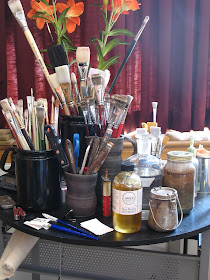I get to play with a lot of fun toys. It is a matter of personal pride and good craftsmanship that artists have often sought to make beautiful paintings with beautiful materials. The finest, and most expensive materials have traditionally been reserved for the most important subjects. The blue of the Madonna's robe is one such example. Few artists today use gold leaf and genuine lapis-- $170 for 5 grams.
I know I probably get more excited about these sorts of things than most. Consider that I wrote three posts about preparing a surface upon which to paint. For those who are interested, a word about what I'm using to make the painting.
Some artists are very mysterious about their materials, as if a neophyte bought a jar of the right stuff she might but the master out of business. It's ridiculous that the any substance, like a philosopher's stone, could transform a mediocre painting into something great. I suppose that the difficulty of painting, its slow learning curve, and the transubstantial beauty of the great works of art do provoke such speculation.
I use very little besides oil paint and mineral spirits. When painting into wet paint I like to use Gamblin's Neo Megilp. Sometimes I make my own medium with stand oil and mineral spirits. There's nothing special about my mediums. Grumbacher, Winsor & Newton, and probably every other company makes something similar. I like Gamblin because they make high quality products which are as non-toxic and environmentally friendly as possible. Rather than send the pigment dust from their air filters to a landfill, they make paint from it, and hold a competition. Come by my classroom on September 27th to participate. Materials provided.
I use Williamsburg paint. It's made in the US. It used to be made by hand by Carl Plansky. Now they're a Golden brand, but are still made in small batches according to Carl's recipes. It's the best paint. The Cadillac of paint. I don't tolerate differences of opinion on this subject. I will concede that Old Holland and a few others might be as good. Winsor and Newton I have a soft spot for, as a watercolorist. But I've used a lot of paint, and nothing compares to Williamsburg Cadmiums. Their Cerulean is like the singing of the angels. Of their Viridian, Guignet would be proud. Even their Yellow Ochre is spectacular. To use other paints after using these is depressing. Concern for my students finances compels me to include a less expensive paint in their supply kits, but do try to make a good case for buying the best.
Regarding brushes, the bigger the better, says Da Vinci. The best brushes are made in Germany, of the hair of the finest Chongqing hogs. Don't worry: they're being slaughtered for their pork. So painters need not worry that animals are being harmed. It's good to make use of the whole animal. The Czech Republic used to raise some pretty good hogs, but no more. With brushes, brands don't matter. If a company is buying high quality materials, they're not going to spoil them with shoddy craftsmanship. If it says Chongqing bristle, you're getting the good stuff. I also like sable brushes and lettering brushes for more delicate work. Dick Blick makes a scholastic "one stroke" and Utrecht a Sablette, both of which I use a lot. They're so cheap you can just throw them out rather than clean them if you like.


No comments:
Post a Comment